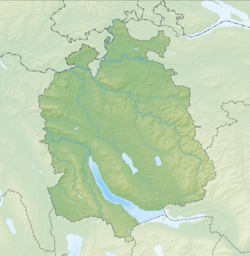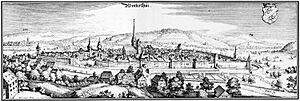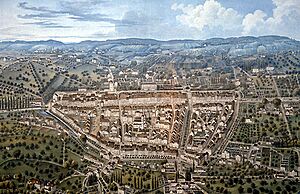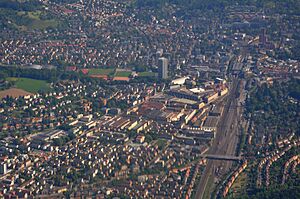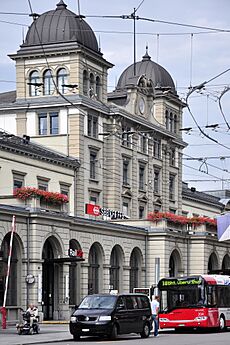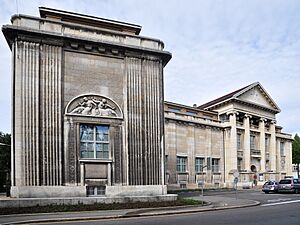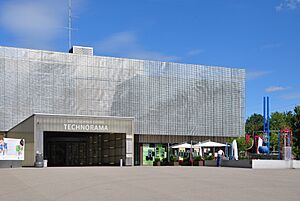Winterthur facts for kids
Quick facts for kids
Winterthur
|
||
|---|---|---|
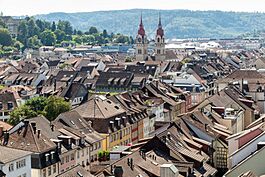
View of the old town
|
||
|
||
| Country | Switzerland | |
| Canton | Zürich | |
| District | Winterthur | |
| Area | ||
| • Total | 68.07 km2 (26.28 sq mi) | |
| Elevation
(Bahnhofplatz)
|
439 m (1,440 ft) | |
| Highest elevation
(Hulmen)
|
687 m (2,254 ft) | |
| Lowest elevation
(Kläranlage Hard)
|
393 m (1,289 ft) | |
| Population
(Dec 2020 )
|
||
| • Total | 114,220 | |
| • Density | 1,677.98/km2 (4,345.9/sq mi) | |
| Demonym(s) | German: Winterthurer(in) | |
| Postal code |
8400, 8404, 8405, 8406, 8408, 8409, 8404 Stadel (Winterthur), 8404 Reutlingen (Winterthur), 8310 Kempthal, 8352 Ricketwil (Winterthur), 8482 Sennhof (Winterthur), 8542 Wiesendangen, 8545 Rickenbach Sulz
|
|
| Localities | Stadt (city), Dättnau, Deutweg, Ganzenbühl, Grüze, Hegi, Heiligberg, Mattenbach, Oberseen, Oberwinterthur, Rosenberg, Schlosstal, Seen, Töss, Veltheim, Wülflingen, Zinzikon | |
| Surrounded by | Brütten, Dinhard, Elsau, Hettlingen, Illnau-Effretikon, Kyburg, Lindau, Neftenbach, Oberembrach, Pfungen, Rickenbach, Schlatt, Seuzach, Wiesendangen, Zell | |
| Twin towns | Hall in Tirol (Austria), La Chaux-de-Fonds (Switzerland), Pilsen (Czech Republic), Yverdon-les-Bains (Switzerland) | |
Winterthur is a city in northern Switzerland, located in the canton of Zürich. With over 110,000 people living there, it is Switzerland's sixth-largest city. It is also the ninth-largest urban area, with about 140,000 residents. Winterthur is about 20 kilometers (12 miles) northeast of Zürich. It is a hub for services and high-tech industries within the larger Zürich area.
The official language in Winterthur is German. However, most people speak a local version of the Swiss German dialect called Zürich German. People often call Winterthur "Winti" for short.
Winterthur has good train connections to Germany and Zurich Airport. It is also a major transport center. The A1 motorway, which goes from Geneva to St. Margrethen, connects here with the A4 motorway (heading north to Schaffhausen) and the A7 motorway (heading towards the Swiss-German border near Kreuzlingen). The main railway station is the fourth busiest in Switzerland. It is only 20 minutes away from Zürich by train.
Contents
History of Winterthur
Early Beginnings
The area where Winterthur is now was once a Roman settlement called Vitudurum. This was between the first century BC and the third century AD. By the late third century, it became a fortified camp, likely to protect against invasions by the Alamanni.
In the seventh century, the Alamanni people had a settlement here. In 919, a battle near Winterthur helped Burchard II of Swabia gain control over the Thurgau region.
Medieval Times
The counts of Winterthur, a branch of the Bregenz family, built Kyburg castle in the tenth century. In 1053, the castle went to the counts of Dillingen. Winterthur became a city in 1180, founded by Hartmann III of Dillingen. From 1180 to 1263, the city was ruled by the House of Kyburg.
When the Kyburg family ended in 1263, Winterthur became part of the House of Habsburg. The Habsburgs gave Winterthur city rights in 1264. For a short time, from 1415 to 1442, Winterthur was a "free imperial city," meaning it was only answerable to the Holy Roman Emperor. But during the Old Zürich War, it lost this freedom and returned to Habsburg control. In 1467, the Habsburgs sold Winterthur to the city of Zürich because they needed money.
Under Zürich's Rule and French Influence
When Winterthur was under Zürich's control, its economic freedom was limited. It lost many market rights and the ability to trade certain goods. This changed in 1798 when Napoleon's troops took over the town.
On May 27, 1799, the Battle of Winterthur took place here during the French Revolutionary Wars. French and Habsburg armies fought in this battle. Winterthur was important because it was near Zürich and at a crossroads of seven roads. The army that controlled Winterthur could access most of Switzerland. The Austrians fought for 11 hours against the French, which helped them win a few days later in the First Battle of Zurich.
Industrial Growth and Challenges
In the 19th century, Winterthur became an industrial city. Companies like Sulzer, Rieter, and SLM built large factories here.
The city faced financial difficulties in the late 1800s due to investments in a private railway company. Winterthur had to sell its shares and struggled with a large loan. However, the cantonal and federal governments helped with loans.
The Great Depression in the 1930s hit Winterthur very hard. Many people worked in the machine industry, and jobs became scarce. But with the start of World War II, the city's industries grew again. In 2008, Winterthur's population reached 100,000.
Geography of Winterthur
City Landscape
Winterthur is located at an elevation of 439 meters (1,440 feet). The city sits in a valley south and east of the Töss river. The Töss flows into the High Rhine about 10 kilometers (6 miles) away. A smaller river called the Eulach flows through the middle of the town from east to west, joining the Töss. Because of this, Winterthur is sometimes called "Eulachstadt." Zürich is about 20 kilometers (12 miles) southwest of Winterthur.
Land Use
Winterthur covers an area of 68.1 square kilometers (26.3 square miles). About 24.8% of this land is used for farming. Forests cover 40.4% of the area. Buildings and roads make up 33.6% of the city. Only 1.1% is non-productive land, like rivers or mountains. In 1996, housing and buildings made up 21.9% of the total area. As of 2007, 27.6% of the city's land was under construction.
People of Winterthur
| Significant minority groups | |
| Nationality | Population (2015) |
|---|---|
| 4,942 | |
| 4,577 | |
| 2,032 | |
| 1,849 | |
| 1,439 | |
| 1,285 | |
| 1,049 | |
As of July 2008, Winterthur had a population of 100,000 people. More recently, the population has grown to over 110,000. About 23.6% of the people in Winterthur are foreign nationals. In 2008, 48.6% of the population was male and 51.4% was female. Over the last 10 years, the population has grown by 10.4%.
Most people in Winterthur (83.0%) speak German. Italian is the second most common language (4.9%), followed by Albanian (2.0%).
The age breakdown of the population in 2018 shows that children and teenagers (0–19 years old) make up 19.9%. Adults (20–64 years old) are 63.9% of the population. Seniors (over 64 years old) make up 16.2%. There are 42,028 households in Winterthur.
In 2008, about 37.1% of the population belonged to the Swiss Reformed Church. Another 26.7% were Catholic. Many other Christian faiths are also present. About 11.5% of the population was Muslim. A significant portion (16.6%) did not belong to any organized faith.
Economy of Winterthur
Winterthur was historically known for its rail and heavy industries. However, most of these industries have now closed down. One of the most important companies was Sulzer Brothers, now known as Sulzer Ltd.. The textile industry also declined earlier. The Rieter textile machinery company is still based in Winterthur.
Switzerland's largest bank, Union Bank of Switzerland (now UBS AG), was founded in Winterthur. The local newspaper, Landbote, is also based here.
Peraves, a company that makes unique fully enclosed "cabin motorcycles" called Monotracers, has been operating in Winterthur since the 1980s. In 2010, Peraves won the Progressive Insurance Automotive X-Prize with an electric version of their Monotracer.
Winterthur was also home to Winterthur Insurance, once Switzerland's largest insurance company. In 2007, the French AXA group bought it, and it is now known as AXA Winterthur.
As of 2011, Winterthur had an unemployment rate of 3.53%. In 2017, about 185 people worked in farming. The manufacturing sector employed 11,880 people. The service sector, which includes jobs like retail, healthcare, and finance, employed 59,767 people. In 2007, nearly half of the working population (47.9%) worked full-time, and 52.1% worked part-time.
Education in Winterthur
Winterthur is known for its strong educational institutions. About 70.7% of the population between 25 and 64 years old have completed higher education. This includes either non-mandatory secondary education or university studies.
The city is famous for its Technikum, which is Switzerland's largest technology school. This institute has recently joined with schools from Zürich. It is now called Zürcher Hochschule für Angewandte Wissenschaften (ZHAW).
The headquarters of the Club of Rome, an organization that studies global challenges, are located in Winterthur. SIS Swiss International School also has a campus in Winterthur.
Transport in Winterthur
Bahnhof Winterthur, the central station, is one of the busiest stations in Switzerland. About 105,000 passengers use it every day. Since the city is close to Zürich, many local Zürich S-Bahn trains serve it. EuroCity trains to Munich and regional trains to places like St. Gallen also stop here.
Besides the main station, there are nine other train stations within the city. These include Oberwinterthur, Seen, Grüze, and Töss.
Local public transport is managed by Stadtbus Winterthur. They operate twelve city bus lines, including the Winterthur trolleybus system, and five regional bus lines.
Winterthur also has two small airports: Winterthur Hegmatten (LSPH) and Speck (LSZK).
Tourism in Winterthur
Winterthur is not a main tourist destination in Switzerland, so it does not have many hotels. Many visitors often stay in Zürich and travel to Winterthur because it is easy to reach by public transport.
However, Winterthur is known for its many museums, which offer world-class art. Some of the most famous museums include:
- Oskar Reinhart Collection 'Am Römerholz'
- Oskar Reinhart Collection am Stadtgarten
- Kunstmuseum Winterthur
- Villa Flora
- Fotomuseum Winterthur
- Swiss Science Center Technorama
Culture in Winterthur
Music and Festivals
Winterthur's chamber orchestra, Orchester Musikkollegium Winterthur, is the oldest orchestra in Switzerland. It also performs at the Zurich Opera. The city hall, Stadthaus, where the orchestra plays, was designed by Gottfried Semper.
The Musikfestwochen is a music festival held in late August and early September. During this time, Winterthur's Old Town fills with live music in the streets, bars, and concert venues.
The "Albanifest" is the largest annual festival in a historic Swiss town. It takes place over three days in late June each year. The festival celebrates the city receiving its charter in 1264 from Rudolf of Habsburg. This happened on June 22, which was Saint Alban's day.
The church of St. Laurenz in the city center dates back to 1264. The town hall was built in 1781.
In 1989, Winterthur received the Wakker Prize for its efforts to develop and preserve its beautiful old buildings.
The Swiss folk metal band Eluveitie was formed in Winterthur. The Punkabilly band The Peacocks is also from here.
Arts and Open Doors
Open Doors is a special event where artists in Winterthur open their studios to the public. This platform helps artists connect with the community and show their work. Open Doors happens every year during the last weekend of September. Visitors can see artists working and learn about their art. About 60 artists participate, including local, international, self-taught, and art school graduates.
Open Doors Winterthur was started in 2008 by Michelle Bird, an artist from San Francisco who lives in Winterthur. The event publishes an annual MAP Magazine Artist Professionals that features articles about local art and profiles artists and their studios. A map helps visitors find the artists' studios.
Sports in Winterthur
EHC Winterthur is the city's main hockey team. They play in the Swiss League, which is the second-highest ice hockey league in Switzerland. Their home arena is the 3,000-seat Deutweg Arena. In April 2011, this arena hosted the top division of the 2011 IIHF Women's World Championship.
FC Winterthur is the city's football (soccer) club. They currently play in the Swiss Super League. Their home stadium is the Stadion Schützenwiese.
Pfadi Winterthur is a professional handball club. They have won many national championships and still play in the Swiss First League of Handball. They share the Winterthur Central Sports Hall with the top floorball club, HC Rychenberg Winterthur.
The Winterthur Lions AFC, founded in 2017, play Australian rules football in the AFL Switzerland league.
Notable People from Winterthur
Born 1800–1850
- Jonas Furrer (1805–1861), a politician who became the first Federal President of Switzerland.
- David Eduard Steiner (1811–1860), a painter and lithographer.
- Konrad Grob (1828–1904), a lithographer and painter.
- Jacob Weidenmann (1829–1893), a landscape architect.
Born 1851–1900
- Charles E. L. Brown (1863–1924), a machine designer and co-founder of Brown, Boveri & Cie.
- Heinrich Wölfflin (1864–1945), an art historian.
- Hans Gamper (1877–1930), a sportsman and founder of FC Barcelona.
- Alfred Büchi (1879–1959), the inventor of the exhaust gas turbocharger.
- Werner Reinhart (1884–1951), an industrialist and supporter of the arts.
- Oskar Reinhart (1885–1965), a famous art collector and patron.
- Emil Brunner (1889–1966), a reformed theologian.
Born 1901–1950
- Georges Miez (1904–1999), a gymnast.
- Max Bill (1908–1994), an architect, artist, and designer.
- Richard R. Ernst (1933–2021), a chemist who won the Nobel Prize in 1991.
- Hannes Keller (born 1934), a computer pioneer and diving pioneer.
- Niklaus Wirth (1934–2024), a computer scientist.
- Markus Imhoof (born 1941), a film director and screenwriter.
Born 1951–2000
- Viktor Giacobbo (born 1952), a Swiss writer, comedian, and actor.
- Martin Buser (born 1958), a Swiss dog musher and four-time Iditarod champion.
- Chrigel Glanzmann (born 1975), a Swiss musician and founder of the band Eluveitie.
- Steven Zuber (born 1991), a Swiss professional football player.
- Mirco Müller (born 1995), a Swiss ice hockey player.
See also
 In Spanish: Winterthur para niños
In Spanish: Winterthur para niños




